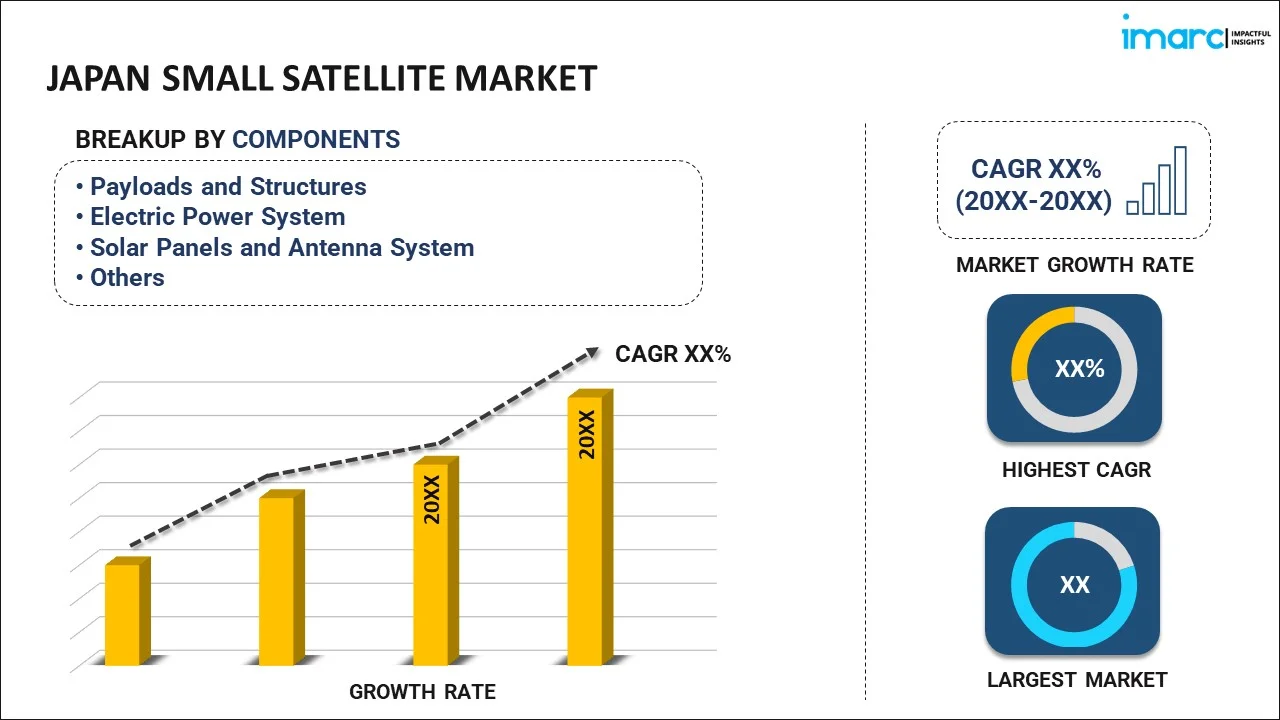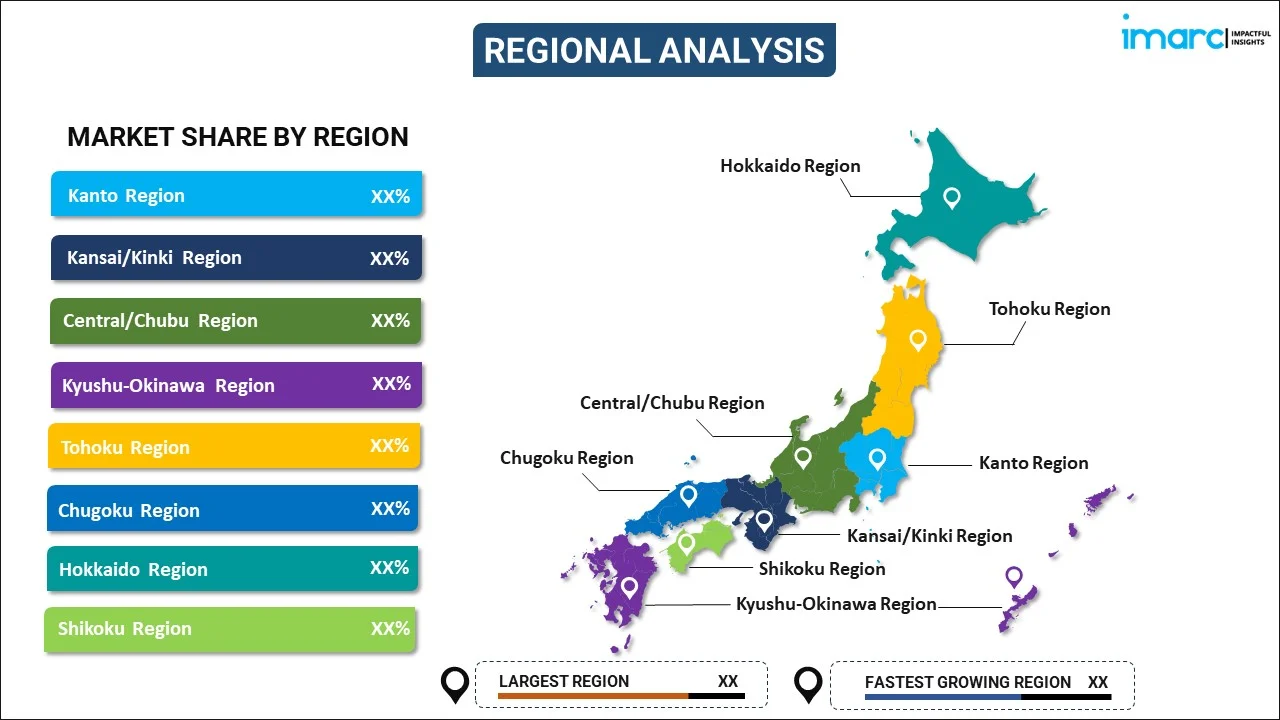
Japan Small Satellite Market Report by Component (Payloads and Structures, Electric Power System, Solar Panels and Antenna System, Propulsion System, and Others), Type (Mini Satellite, Micro Satellite, Nano Satellite, and Others), Frequency (L-Band, S-Band, C-Band, X-Band, Ku-Band, Ka-Band, Q/V-Band, HF/VHF/UHF-Band, and Others), Application (Communication, Earth Observation and Remote Sensing, Science and Exploration, Mapping and Navigation, Space Observation, and Others), End User (Commercial, Academic, Government and Military, and Others), and Region 2025-2033
Market Overview:
Japan small satellite market size reached USD 328.8 Million in 2024. Looking forward, IMARC Group expects the market to reach USD 685.1 Million by 2033, exhibiting a growth rate (CAGR) of 8.5% during 2025-2033. The escalating demand for remote sensing and Earth observation services across various sectors, such as energy, oil and gas, defense, agriculture, etc., is primarily catalyzing the market growth.
|
Report Attribute
|
Key Statistics
|
|---|---|
|
Base Year
|
2024 |
|
Forecast Years
|
2025-2033 |
|
Historical Years
|
2019-2024
|
| Market Size in 2024 | USD 328.8 Million |
| Market Forecast in 2033 | USD 685.1 Million |
| Market Growth Rate (2025-2033) | 8.5% |
A small satellite, commonly referred to as a smallsat, is a type of satellite characterized by its compact size and low mass, typically weighing less than 1,200 kilograms. These satellites are further classified based on their weight into categories like minisatellites, microsatellites, nanosatellites, picosatellites, and femtosatellite. Small satellites offer cost-effective options that empower commercial entities, non-profit organizations, and educational institutions to engage in missions within the lower Earth orbit. They enable a wide range of scientific investigations and technology demonstrations to be conducted in space at a reduced expense, with relative simplicity, and within specified timeframes. Consequently, small satellites find extensive application in various fields, including communication and navigation, serving the needs of civil, commercial, military, and governmental entities.
Japan Small Satellite Market Trends:
The increasing demand for remote sensing and Earth observation services across various sectors, including energy, oil & gas, defense, and agriculture, is a primary driver of the small satellite market in Japan. Moreover, the widespread use of small satellites for communication and navigation, fueled by the growing popularity of advanced technologies like over-the-top (OTT) services and Internet Protocol Television (IPTV), is further stimulating the market's growth locally. Additionally, the surging need for low Earth orbit (LEO)-based small satellites to deliver affordable broadband services in developing regions is propelling market expansion within Japan. Furthermore, the incorporation of small satellites into the telecom industry is expediting the deployment of 5G technology, generating fresh opportunities for satellite communication (Satcom) companies and fostering a positive outlook for the Japanese market. Besides this, academic institutions and research organizations in Japan are also making extensive use of small satellites for educational purposes and technological experimentation in space, aligning with initiatives such as NASA's CubeSat program, which encourages collaboration on upcoming small satellite launches. In addition, the increasing integration of innovative technologies such as robotics, artificial intelligence, and machine learning to enhance communication efficiency, spacecraft reliability, and coordination is expected to further bolster Japan's small satellite market in the foreseeable future.
Japan Small Satellite Market Segmentation:
IMARC Group provides an analysis of the key trends in each segment of the market, along with forecasts at the country level for 2025-2033. Our report has categorized the market based on component, type, frequency, application, and end user.
Component Insights:

- Payloads and Structures
- Electric Power System
- Solar Panels and Antenna System
- Propulsion System
- Others
The report has provided a detailed breakup and analysis of the market based on the component. This includes payloads and structures, electric power system, solar panels and antenna system, propulsion system, and others.
Type Insights:
- Mini Satellite
- Micro Satellite
- Nano Satellite
- Others
A detailed breakup and analysis of the market based on the type have also been provided in the report. This includes mini satellite, micro satellite, nano satellite, and others.
Frequency Insights:
- L-Band
- S-Band
- C-Band
- X-Band
- Ku-Band
- Ka-Band
- Q/V-Band
- HF/VHF/UHF-Band
- Others
The report has provided a detailed breakup and analysis of the market based on the frequency. This includes L-band, S-band, C-band, X-band, Ku-band, Ka-band, Q/V-band, HF/VHF/UHF-band, and others.
Application Insights:
- Communication
- Earth Observation and Remote Sensing
- Science and Exploration
- Mapping and Navigation
- Space Observation
- Others
A detailed breakup and analysis of the market based on the application have also been provided in the report. This includes communication, earth observation and remote sensing, science and exploration, mapping and navigation, space observation, and others.
End User Insights:
- Commercial
- Academic
- Government and Military
- Others
The report has provided a detailed breakup and analysis of the market based on the end user. This includes commercial, academic, government and military, and others.
Regional Insights:

- Kanto Region
- Kansai/Kinki Region
- Central/ Chubu Region
- Kyushu-Okinawa Region
- Tohoku Region
- Chugoku Region
- Hokkaido Region
- Shikoku Region
The report has also provided a comprehensive analysis of all the major regional markets, which include Kanto Region, Kansai/Kinki Region, Central/ Chubu Region, Kyushu-Okinawa Region, Tohoku Region, Chugoku Region, Hokkaido Region, and Shikoku Region.
Competitive Landscape:
The market research report has also provided a comprehensive analysis of the competitive landscape. Competitive analysis such as market structure, key player positioning, top winning strategies, competitive dashboard, and company evaluation quadrant has been covered in the report. Also, detailed profiles of all major companies have been provided.
Japan Small Satellite Market Report Coverage:
| Report Features | Details |
|---|---|
| Base Year of the Analysis | 2024 |
| Historical Period | 2019-2024 |
| Forecast Period | 2025-2033 |
| Units | Million USD |
| Scope of the Report | Exploration of Historical Trends and Market Outlook, Industry Catalysts and Challenges, Segment-Wise Historical and Future Market Assessment:
|
| Components Covered | Payloads and Structures, Electric Power System, Solar Panels and Antenna System, Propulsion System, Others |
| Types Covered | Mini Satellite, Micro Satellite, Nano Satellite, Others |
| Frequencies Covered | L-Band, S-Band, C-Band, X-Band, Ku-Band, Ka-Band, Q/V-Band, HF/VHF/UHF-Band, Others |
| Applications Covered | Communication, Earth Observation and Remote Sensing, Science and Exploration, Mapping and Navigation, Space Observation, Others |
| End Users Covered | Commercial, Academic, Government and Military, Others |
| Regions Covered | Kanto Region, Kansai/Kinki Region, Central/ Chubu Region, Kyushu-Okinawa Region, Tohoku Region, Chugoku Region, Hokkaido Region, Shikoku Region |
| Customization Scope | 10% Free Customization |
| Post-Sale Analyst Support | 10-12 Weeks |
| Delivery Format | PDF and Excel through Email (We can also provide the editable version of the report in PPT/Word format on special request) |
Key Questions Answered in This Report:
- How has the Japan small satellite market performed so far and how will it perform in the coming years?
- What has been the impact of COVID-19 on the Japan small satellite market?
- What is the breakup of the Japan small satellite market on the basis of component?
- What is the breakup of the Japan small satellite market on the basis of type?
- What is the breakup of the Japan small satellite market on the basis of frequency?
- What is the breakup of the Japan small satellite market on the basis of application?
- What is the breakup of the Japan small satellite market on the basis of end user?
- What are the various stages in the value chain of the Japan small satellite market?
- What are the key driving factors and challenges in the Japan small satellite?
- What is the structure of the Japan small satellite market and who are the key players?
- What is the degree of competition in the Japan small satellite market?
Key Benefits for Stakeholders:
- IMARC’s industry report offers a comprehensive quantitative analysis of various market segments, historical and current market trends, market forecasts, and dynamics of the Japan small satellite market from 2019-2033.
- The research report provides the latest information on the market drivers, challenges, and opportunities in the Japan small satellite market.
- Porter's five forces analysis assist stakeholders in assessing the impact of new entrants, competitive rivalry, supplier power, buyer power, and the threat of substitution. It helps stakeholders to analyze the level of competition within the Japan small satellite industry and its attractiveness.
- Competitive landscape allows stakeholders to understand their competitive environment and provides an insight into the current positions of key players in the market.
Need more help?
- Speak to our experienced analysts for insights on the current market scenarios.
- Include additional segments and countries to customize the report as per your requirement.
- Gain an unparalleled competitive advantage in your domain by understanding how to utilize the report and positively impacting your operations and revenue.
- For further assistance, please connect with our analysts.
 Inquire Before Buying
Inquire Before Buying
 Speak to an Analyst
Speak to an Analyst
 Request Brochure
Request Brochure
 Request Customization
Request Customization




.webp)




.webp)












